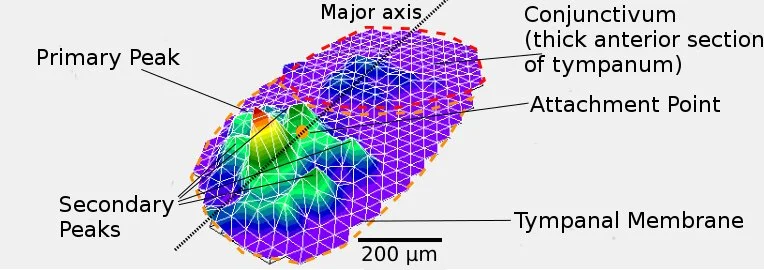Insect-inspired microphones
- May 11, 2023
- 0
What can an insect hear? Surprisingly enough. Although they are small and simple, their auditory system is very effective. For example, with a membrane of only 2 millimeters,
What can an insect hear? Surprisingly enough. Although they are small and simple, their auditory system is very effective. For example, with a membrane of only 2 millimeters,

What can an insect hear? Surprisingly enough. Although they are small and simple, their auditory system is very effective. For example, with a membrane of only 2 millimeters, the desert locust can emit frequencies comparable to human abilities. By understanding how insects detect sound and using 3D printing technology to create custom materials, miniature biotechnology-inspired microphones can be developed.
Andrew Reid of the University of Strathclyde in the UK presented his work on creating such microphones that can autonomously collect acoustic data with low power consumption. His presentation titled “Unnatural Hearing – 3D Printing of Functional Polymers as a Pathway to Biotechnology-Inspired Microphone Design” was presented on Wednesday, May 10, at the 184th meeting of the Acoustic Society of America.
“Bug ears are ideal templates for reducing energy and data costs, reducing the size of sensors and eliminating data processing,” said Reid.
Reid’s team draws inspiration from insect ears in several ways. At the chemical and structural levels, researchers are using 3D printing technology to make special materials that mimic insect membranes. These synthetic membranes are highly sensitive and efficient acoustic sensors. Without 3D printing, traditional silicon microphones lack the necessary flexibility and customization.
“In the images, our microphone looks like any other microphone. “The mechanical element is a simple diaphragm, perhaps a somewhat unusual ellipsoidal or rectangular shape,” Reid said. “Interesting details emerge with small changes in thickness and porosity at the microscale, and changes in material properties such as material cohesion and density at the nanoscale.”
More than just material, the entire data collection process is inspired by biological systems. Unlike traditional microphones that collect a range of information, these microphones are designed to detect a specific signal. This simplified process is similar to the way nerve endings perceive and transmit signals. The sensor’s expertise allows it to quickly recognize triggers without consuming too much power or requiring supervision.
With their small size, autonomous functionality and low power consumption, bio-based sensors are ideal for hazardous or hard-to-access applications, including locations embedded in structures or inside the human body.
Biotechnology-inspired 3D printing technologies can be applied to many other tasks, including blood-brain barrier organoids or ultrasound structural monitoring.
Source: Port Altele
As an experienced journalist and author, Mary has been reporting on the latest news and trends for over 5 years. With a passion for uncovering the stories behind the headlines, Mary has earned a reputation as a trusted voice in the world of journalism. Her writing style is insightful, engaging and thought-provoking, as she takes a deep dive into the most pressing issues of our time.